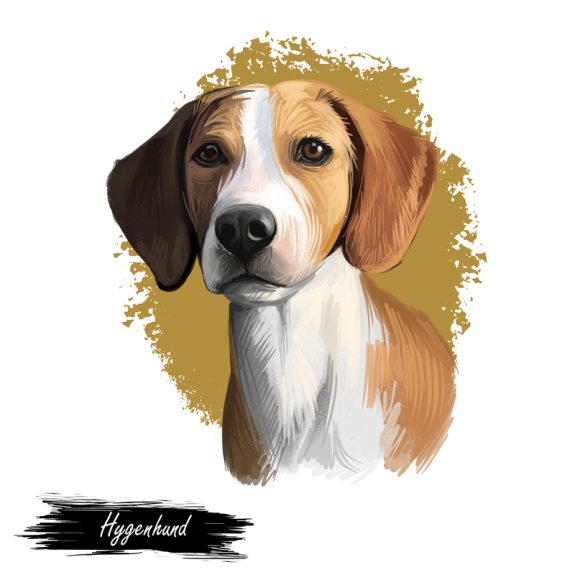
Of Norway’s seven native breeds, three are scent hounds, and of these, the Hygen Hound may be the most at risk, and the most difficult to find even in Norway. This is a bit surprising to us as the Hygen Hound (also seen written as one word) is a remarkable scent hound in a country where hunting is deeply engrained in the history and its culture. In fact, because of Norway’s high standards for competence and ethics, 74% of Norwegians view hunting as an acceptable and even desirable activity. To hunt larger game, hunters must not only pass an annual shooting test, they must also have a trained tracker dog with them when they hunt so that injured animals can be tracked down and humanely killed.
The Hygen Hound is a superb hunter. He is medium sized, friendly and calm, and a lovely dog to have around the house, so we were baffled by why it doesn’t enjoy more popularity in its homeland. We came across a sentence buried in a source, however, that may shed a little light on the matter if true: Hygen Hounds have gained a reputation for being territorial and possessive which may be problematic in a home with children. Still, it doesn’t explain why the breed isn’t used more by retirees or found in homes without children. Perhaps it’s just too hard to find?
According to an article published in 2012 in the newspaper Aftenposten, the Hygen Hound was one of the six Norwegian dog breeds at risk of extinction*. In 2015, only 23 Hygen Hounds were registered in Norway, and none in the other Scandinavian countries. This is cause for concern, particularly for a breed with deep Norwegian roots.
The Hygen Hound is named after Hans Fredrik Hygen, a 19th century Norwegian procurator who sought to develop the ideal hunting dog for a particular niche: An ability to endure the harshest of Scandinavian winter weather conditions over arctic terrain without tiring too quickly. Around 1830, Hygen selectively bred from local scent hounds such as the Ringerike Hound, as well as with several Holsteiner Hounds he had acquired in Germany. When he moved to the region of Romerike in 1839, he included that area’s dogs in his breeding program, as well.
Hygen’s children carried on with his breeding plans, and his son, A. B. Hygen, became one of the founding members of the “Special Club for Norwegian Scent Hounds” in 1902. Indeed, he had a key role in writing the breed standard published the same year. As it happens, that was also the year that the Norwegian Hound and the Hygen Hound were defined as two separate breeds. Before then, the Norwegian Kennel Club had integrated the Hygen Hound with the Norwegian Hound and called both breeds “Norwegian Hare Hounds” because of the former’s limited number.
In another post, we’ll cover the tumultuous years that faced the breed in subsequent years, and what measures were taken to enlarge its gene pool before and after the First World War. The effort is on-going, and despite the rarity of the breed, the Hygen Hound was recognized by the FCI in 1999, and the United Kennel Club in 2006.
In our view, as noble as it is to adopt a dog, saving an entire breed from extinction is nothing short of conservation. Think Panda Bear.
*Of the six Norwegian dog breeds, only the Norwegian Elkhound is considered safe from extinction.
Images: Artwork by © Iryna Zaichenko/Dreamstime.com.
